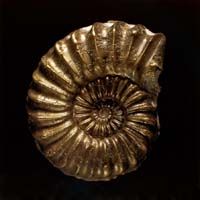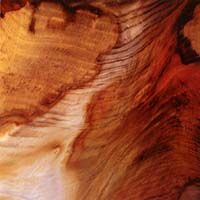Ancient Microworlds
June 11–September 7, 2003
Nature has been the artist’s muse for centuries. The twenty photographs in this exhibition magnify forms, textures, and colors of fossils ordinarily invisible to the naked eye. Physician and archaeologist Giraud Foster and biomedical/scientific photographer Norman Barker collaborated for twelve years, merging art and science into an innovative, high-magnification photographic technique, to produce boldly colored images. They select fossil specimens that are particularly striking in at least one field of vision under high magnification. At the same time, they seek to reveal dynamic compositions of color and varied texture.
This exhibition was organized by the McMullen Museum of Art with text by faculty of the Boston College Geology and Geophysics Department: Paul Strother, David Krauss, and Ken Galli. The photographs are a recent gift to the Museum from Giraud Foster and Norman Barker.

About Fossils
Fossils are windows into our geologic past; we look through them to help understand the evolution of life on Earth. But it is only under rare circumstances that any organic remains petrify, so what we actually see are little snapshots of the history of life—not all that unlike what is displayed in this exhibit. Many of the images displayed here are “petrifactions”—fossils in which the mineral chert (a cryptocrystalline form of quartz) has faithfully preserved internal structure at the cellular level. With this degree of detail, paleontologists can compare modern organisms with their fossil counterparts, revealing much about the tempo and pattern of our ancient past in microcosm.
One lesson we learn from the photographs presented in this exhibition is the progressive evolution of the plant kingdom. The stromatolite from two billion years ago contains evidence of a microbial world that covered the Earth’s surface long before plants evolved. By Carboniferous time, vast coal swamps covered much of North America and Europe. The plants that populated these swamps included a mixture of ferns, giant lycopods, and conifers whose ancestors persist today. But other groups, like the pteridosperms (tree ferns) are long extinct. These early seed-bearing plants, or angiosperms, belonged to the groups that eventually gave rise to the flowering plants that dominate the contemporary landscape.
In the petrified oak (above right) we see wood with large water-conducting cells called “vessels”—one of the evolutionary innovations that characterize the angiosperms. Overall, plant fossils demonstrate that water is the driving selective force in the evolution of major plant groups. Plants developed woody tissue for water transport from soil to leaf, and over time, seeds replaced spores as the principal means of reproduction and dispersal. The angiosperms have achieved complete independence from free films of water in their reproduction.

